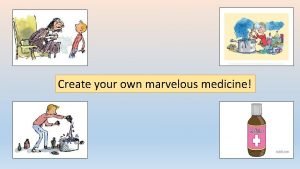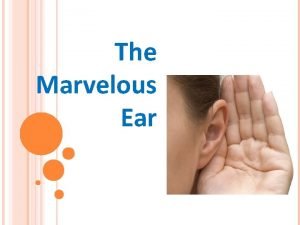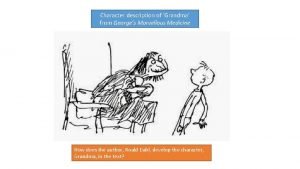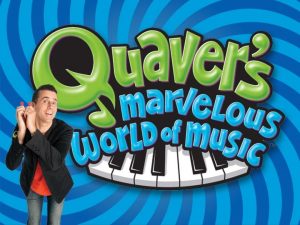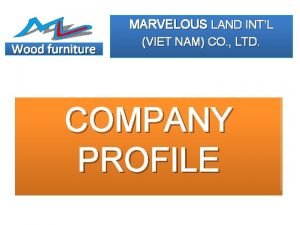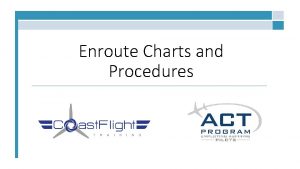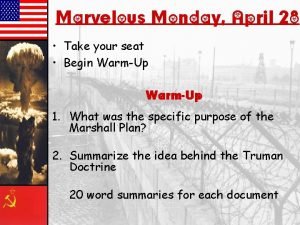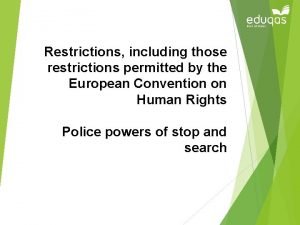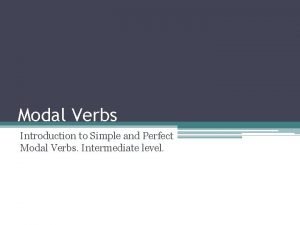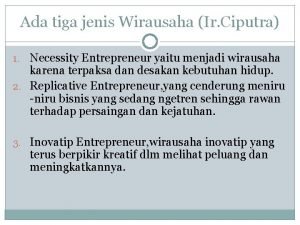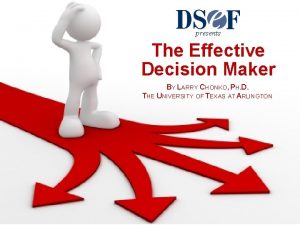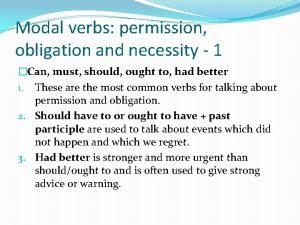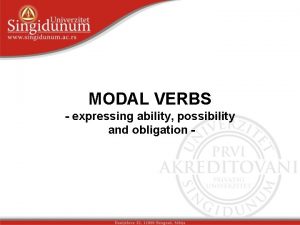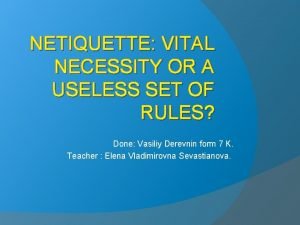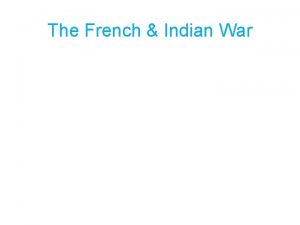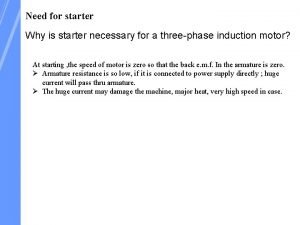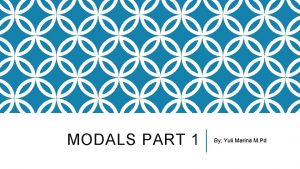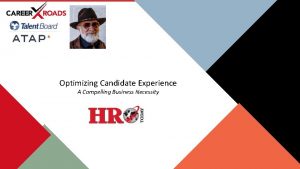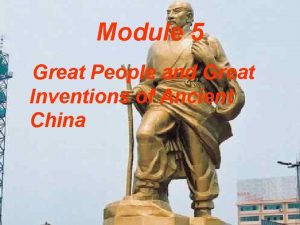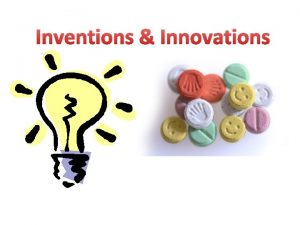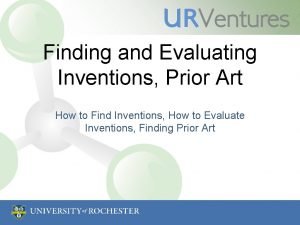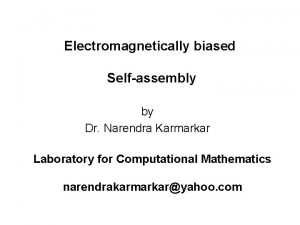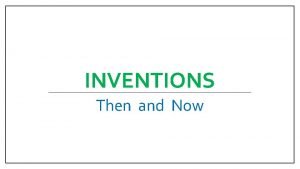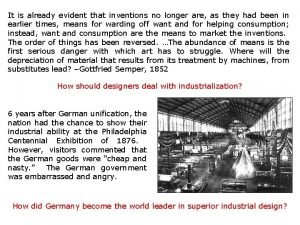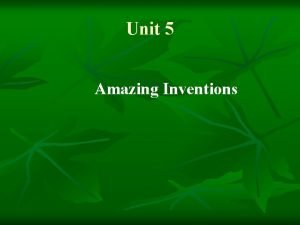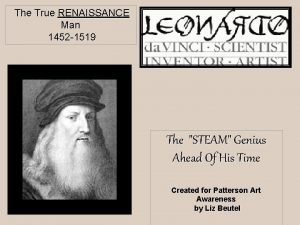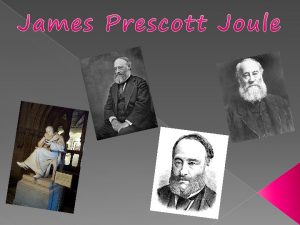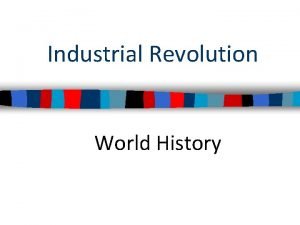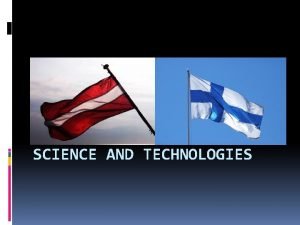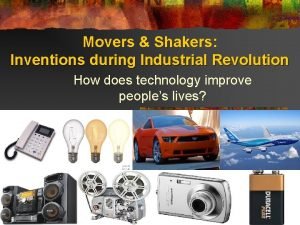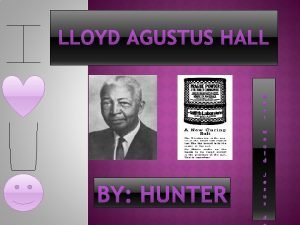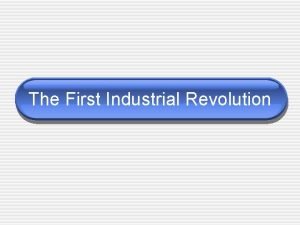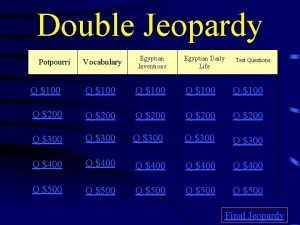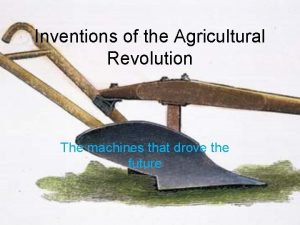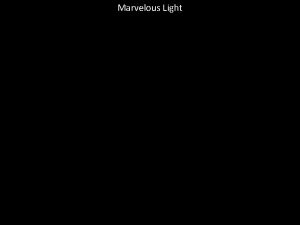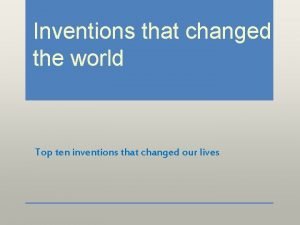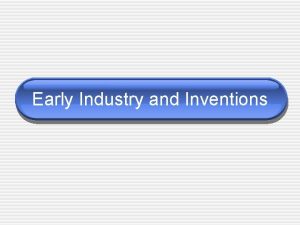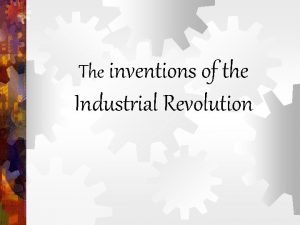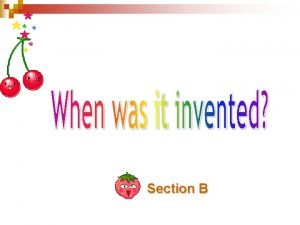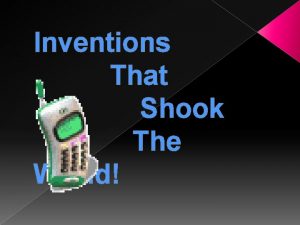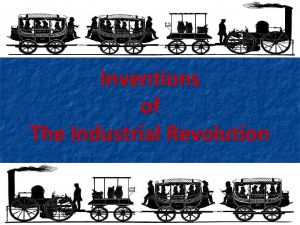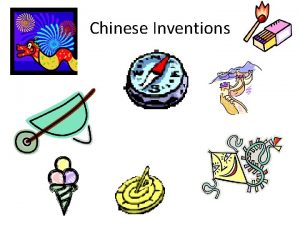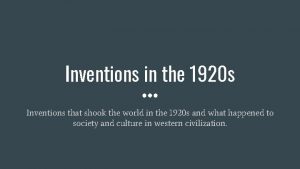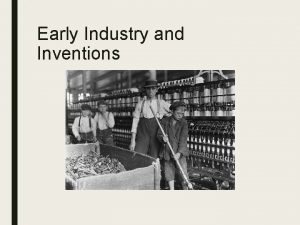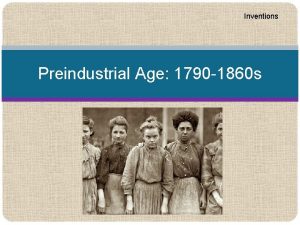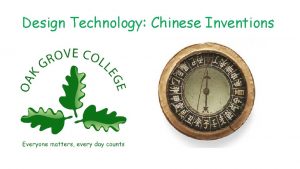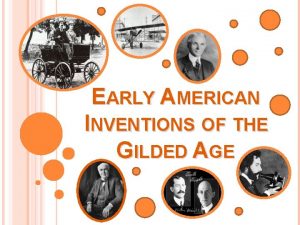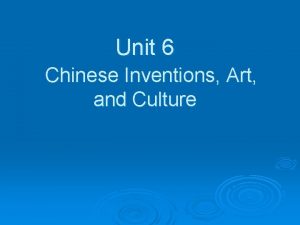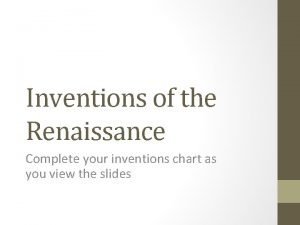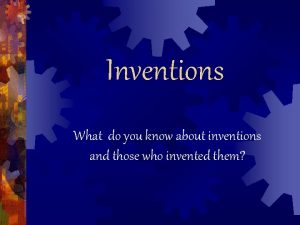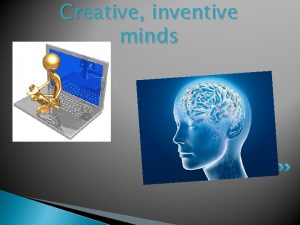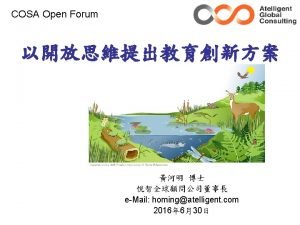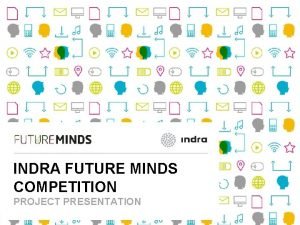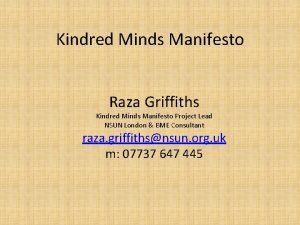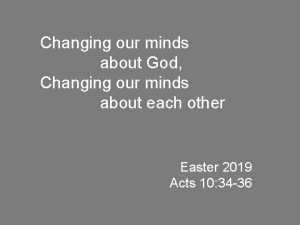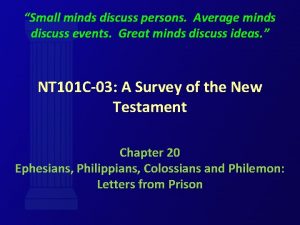INVENTIONS 9 1 MARVELOUS MINDS NECESSITY IS THE










































- Slides: 42

INVENTIONS 9. 1. MARVELOUS MINDS

NECESSITY IS THE MOTHER OF INVENTION. PLATO, 427 BC – 347 BC, Greek philosopher READING

1. page 74, What do you know about the three people in the pictures? Alfred Nobel Leonardo da Vinci Levi Strauss

2. page 74, Leonardo da Vinci was a famous inventor. Look at these inventions? Which are his ideas or inventions? • the bicycle • the car • the diving suit • the helicopter • high heels • the parachute /ˈparəʃuːt/ • the radio • the robot • the telescope • Read the text Leonardo da Vinci quickly and check your ideas.

to dive /dʌɪv/– roniti, zaroniti

2. page 74, answers • • • the bicycle the car √ the diving suit √ the helicopter √ high heels √ the parachute √ the radio the robot √ the telescope

3. page 74, Read the text again. Are the sentences true or false? • 1. When he was young, Leonardo was at a large school. • 2. Leonardo was an engineering student. • 3. A lot of modern inventions use his ideas. • 4. The robot could only move its legs. • 5. The car could only travel a short distance. • 6. Leonardo’s helicopter is the same as the modern ones. • 7. Modern divers use Leonardo’s diving glove.

LEONARDO DA VINCI Man of art. Man of ideas. Man of inventions • His life • Leonardo da Vinci (1452 – 1519) lived in a small town in Italy with his grandparents. He studied at home and enjoyed music, singing and mathematics. At the age of 16, he wanted to study art, so he moved to the city of Florence for art classes.

LEONARDO DA VINCI Man of art. Man of ideas. Man of inventions • His life • He finished his studies after four years. He then worked in Milan as an engineer and he started his life as an inventor. In 1500 he returned to Florence and in 1516 he travelled to France, where he stayed for the rest of his life.

LEONARDO DA VINCI Man of art. Man of ideas. Man of inventions • His inventions • Leonardo da Vinci lived and worked before people used electricity and petrol for power, but he had the first ideas for many machines that we use today.

LEONARDO DA VINCI Man of art. Man of ideas. Man of inventions • His inventions • The robot • Leonardo built his robot in 1495. The robot stood up, sat down and held things in its arms.

LEONARDO DA VINCI Man of art. Man of ideas. Man of inventions • His inventions • The car • A single passenger drove the car. It travelled 40 metres at a time.

LEONARDO DA VINCI Man of art. Man of ideas. Man of inventions • His inventions • The helicopter • Leonardo designed the first helicopter but he never made it. His design used a screw into air. This is different from the modern design, but the general idea is similar.

LEONARDO DA VINCI Man of art. Man of ideas. Man of inventions • His inventions • The diving suit • Leonardo made the suit of leather and added pipes to carry the air to the diver. He also invented special gloves for divers. Today, divers use them on their feet!

gloves /ɡlʌvz/ mittens /ˈmɪt(ə)nz/

LEONARDO DA VINCI Man of art. Man of ideas. Man of inventions • These are just some of Leonardo’s hundreds of inventions. He also invented a parachute and even high heels!

to discover, v. discovery, n. discoverer, n. otkriće (nečega što već postoji u prirodi) to invent, v. invention, n. inventor, n. pronalzak (kreiranje ili projektovanje onoga što prethodno nije postojalo)

3. page 74, answers • 1. When he was young, Leonardo was at a large school. F • 2. Leonardo was an engineering student. T • 3. A lot of modern inventions use his ideas. T • 4. The robot could only move its legs. F • 5. The car could only travel a short distance. T • 6. Leonardo’s helicopter is the same as the modern ones. F • 7. Modern divers use Leonardo’s diving glove. F

4. page 74, Put inventions in the text in order of importance. • • • the robot the car the helicopter the diving suit the parachute high heels

PAST SIMPLE (AFFIRMATIVE) GRAMMAR, page 74

page 74, When we talk about finished events and times in the past we use the Past Simple. • In 1500 he returned to Florence. • infinitive RETURN • Past Simple RETURNED

5 a page 74, Read the first paragraph of the text (His life) again and find other examples of the Past Simple. Complete the table below. Infinitive Past Simple returned Note: we usually add –ed to the infinitive to form the past Simple but sometimes there are spelling changes: STUDY STUDIED, TRAVELLED, LIVED

5 b page 74, Listening Track 2. 16 , – transcript page 152, Complete the sentences with your answers from Exercise 5 a. Then listen and check. • 1. Leonardo _______ his studies of art in 1468. • 2. He _____ these studies in 1472. • 3. He _____ money so he started work as an engineer. • 4. Leonardo ____ as an engineer for 32 years. • 5. He _____ in Milan from 1472 to 1500. • 6. He _____ to Florence after 28 years in Milan.

5 b page 74, Listening Track 2. 16 – transcript page 152, answers. • 1. Leonardo STARTED his studies of art in 1468. • 2. He FINISHED these studies in 1472. • 3. He WANTED money so he started work as an engineer. • 4. Leonardo WORKED as an engineer for 32 years. • 5. He LIVED in Milan from 1472 to 1500. • 6. He RETURNED to Florence after 28 years in Milan.

page 75 PRONUNCIATION

6 a page 75, track 2. 17, transcript page 12 Verb endings • The Past Simple ending –ed has three possible pronunciations. Listen to these examples and repeat them. • enjoyed • /ɪnˈdʒɔɪd/ helped /hɛlpt/ needed /ˈniːdɪd/

6 b page 75, Put the verbs from Exercise 5 b in in the correct column, then listen to Track 2. 16 again, transcript page 152, check and repeat the sentences. enjoyed /ɪnˈdʒɔɪd/ helped /hɛlpt/ needed /ˈniːdɪd/

6 b page 75, Track 2. 16, transcript page 152 answers enjoyed /ɪnˈdʒɔɪd/ helped /hɛlpt/ needed /ˈniːdɪd/ lived finished started returned worked wanted

GRAMMAR TIP • Some verbs in the Past Simple are IRREGULAR. We don’t add –ed to the infinitive. • He had the first ideas. (NOT haved!) • He built his robot in 1495. (NOT builded!)

7. page 75, Read the rest of the text (His inventions) again and find the Past Simple forms of these verbs. • • • 1. stand ____ 2. sit _____ 3. hold _____ 4. drive _____ 5. make ______

7. page 75, answers • • • 1. stand STOOD 2. sit SAT 3. hold HELD 4. drive DROVE 5. make MADE

8. page 75, Complete the sentences with the Past Simple of the verbs in brackets. Is each verb regular or irregular (See irregular verb list on page 159. ) • • 1. Last month, I ____ three films in the cinema. (SEE) 2. Last year, we ____ to Hawaii on holiday. (GO) 3. He _____ Russia in 2006. (VISIT) 4. They ______ in a hotel by the sea last summer. (STAY) 5. Yesterday, I _____ home at midnight. (GET) 6. My father ______ mathematics at university. (STUDY) 7. When I was a child, I ____ in a small town. (LIVE) 8. I ____ to class by bus this morning. (COME)

8. page 75, ANSWERS • 1. Last month, I SAW three films in the cinema. IRREGULAR • 2. Last year, we WENT to Hawaii on holiday. IRREGULAR • 3. He VISITED Russia in 2006. REGULAR • 4. They STAYED in a hotel by the sea last summer. REGULAR • 5. Yesterday, I GOT home at midnight. IRREGULAR • 6. My father STUDIED mathematics at university. REGULAR • 7. When I was a child, I LIVED in a small town. REGULAR • 8. I CAME to class by bus this morning. IRREGULAR

page 75 SPEAKING

9. page 75, Tell a partner about last weekend. What verbs do you need to use? Make a list. • Last weekend, I visited my grandparents on Saturday. I had lunch with them. • Last Sunday, I went skiing. I had a great time.


page 75 WRITING

HW 10 a page 75, Look at the information on page 121 about Alfred Nobel and Levi Strauss. Match the information with these inventors and then write a short text about them. INVENTOR___________ _ • • • born 1833, Sweden (study) chemistry (write) poetry, novels, plays (try) to make safe explosive) (kill) brother in an experiment 1864 • (invent) dynamite 1866 • (start) Nobel Prize Foundation 1895 • • INVENTOR ___________ born 1829, Germany (travel) New York 1846 (move) San Francisco 1853 (start) shop for gold miners (sell) equipment and clothes (invent) jeans 1873 (use) material from Nîmes, France (call) material ‘denim’

10 b page 75, Track 2. 18 Listen and compare your texts.

pp. 138 -139 LANGUAGE REFERENCE AND EXTRA PRACTICE, PAGES 138 -139

HW • Read about the Past Simple in page 138, G 1 and G 2 • Do exercises in page 139, G 1, 2: exercises 1 and 2 G 1 -3: exercise 4

Thank you for your Attention!
 George's marvellous medicine story
George's marvellous medicine story The marvelous ears
The marvelous ears Marvelous grace of our loving lord
Marvelous grace of our loving lord George's marvellous medicine grandma character description
George's marvellous medicine grandma character description “our romeo hath not been in bed tonight.”
“our romeo hath not been in bed tonight.” How marvelous i stand amazed
How marvelous i stand amazed Quaver's marvellous world of music theme song
Quaver's marvellous world of music theme song Dinning set furniture
Dinning set furniture Ifr low chart legend
Ifr low chart legend Marvelous monday terrific tuesday wonderful wednesday
Marvelous monday terrific tuesday wonderful wednesday Advokate police
Advokate police Modal verbs introduction
Modal verbs introduction Necessity of fuse
Necessity of fuse Wirausahawan menurut ir ciputra
Wirausahawan menurut ir ciputra False necessity trap
False necessity trap Can verb
Can verb Ability modal
Ability modal Netiquette
Netiquette Necessity of irrigation
Necessity of irrigation What year did george washington attacks ft necessity
What year did george washington attacks ft necessity Stator resistance starter
Stator resistance starter What is the pattern
What is the pattern Business necessity definition
Business necessity definition Module 5 work and inventions
Module 5 work and inventions Inventions
Inventions Pictures of inventions
Pictures of inventions Narendra karmarkar
Narendra karmarkar Mi'kmaq inventions
Mi'kmaq inventions John purdy folding chair
John purdy folding chair Fritz mackensen moormadonna
Fritz mackensen moormadonna Unit 5 inventions
Unit 5 inventions Time created
Time created Asian inventors that changed the world
Asian inventors that changed the world What did james prescott joule discover
What did james prescott joule discover Textile industry inventions
Textile industry inventions Latvian inventions
Latvian inventions Shakers inventions
Shakers inventions Lloyd hall inventions
Lloyd hall inventions Eli whitney interchangeable parts
Eli whitney interchangeable parts Summer inventions
Summer inventions Potpourri category jeopardy
Potpourri category jeopardy Agricultural revolution inventions
Agricultural revolution inventions Nature inspired inventions
Nature inspired inventions
